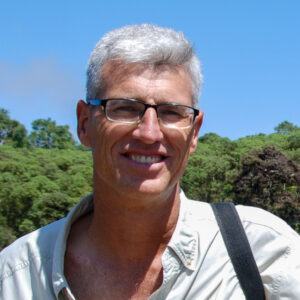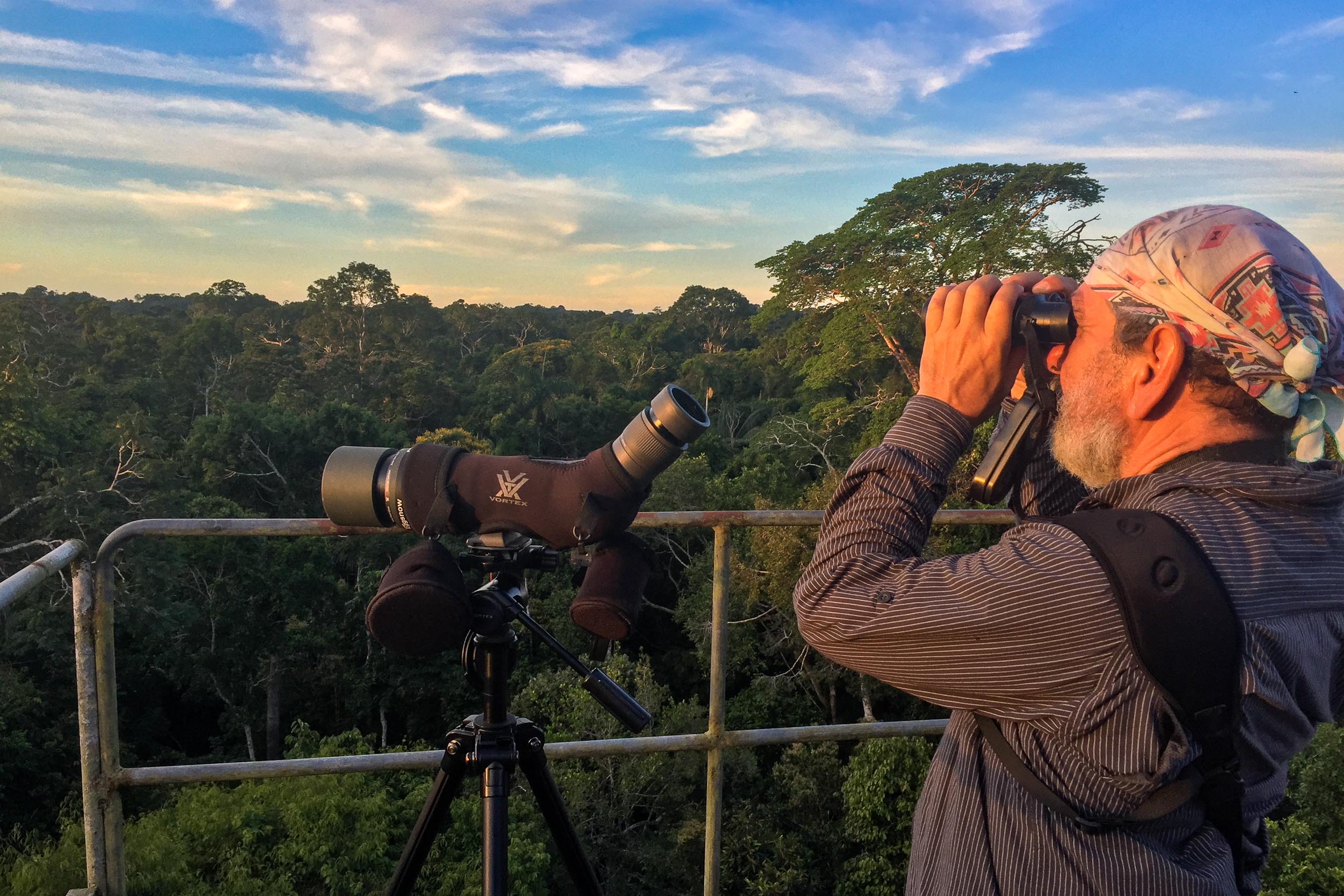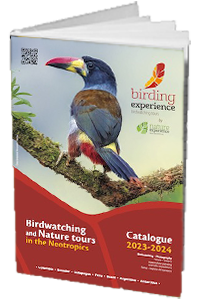Your travel expert
Xavier Amigo
Responsible for naturalist, botanical and ornithological travel. Responsible of fixing and professional contact.

Embark on an unforgettable birdwatching journey accompanied by a specialized guide aboard our scenic cruise around the Galapagos Islands.
Comprising 14 islands and numerous islets and rocks, the Galapagos archipelago was formed by a volcanic hotspot. Additionally, the Galapagos are situated at a convergence point of several ocean currents, resulting in varied climates and seasons. The frigid waters of the Humboldt Current from the south bring nutrients, prompting breeding seasons, while warm northern currents offer respite. Approximately 30% of the seven thousand terrestrial, aquatic, and marine species are endemic, lacking natural predators and providing excellent viewing opportunities. Our 11-day cruise aims to explore the diverse central islands, ensuring encounters with the archipelago's bird, terrestrial, and marine wildlife. Don't forget your binoculars!
Your travel expert
Xavier Amigo
Responsible for naturalist, botanical and ornithological travel. Responsible of fixing and professional contact.

Arrival at Mariscal Sucre International Airport in the Ecuadorian capital at the end of the day. Welcome, transfer, and a short briefing on the upcoming trip. Depending on the flight schedule, we can stroll around our hotel to see some of the typical species of the inter-Andean valley.
Dinner and overnight stay in a comfortable hotel in the inter-Andean valley near the airport.
Private transfer, English-speaking assistance
Morning transfer from your hotel to Quito National Airport, accompanied by one of our team, for your flight to the Galápagos Archipelago. Upon arrival at Puerto Baquerizo, the main port of San Cristóbal, a health and environmental inspection is carried out to protect these fragile ecosystems from exogenous intrusion. Your naturalist guide will be waiting for you at the airport. You will go with them to the pier where your yacht is anchored. You will be welcomed on board by the entire crew and the captain, who will give you a quick welcome briefing and help you get to your cabins and familiarise yourself with the different areas of the ship. In the afternoon, we will explore Cerro Tijeretas, where we will observe a spectacular panoramic landscape, our first Opuntia forests, mockingbirds, finches, and large frigatebird colonies. This will also be the time to discuss Charles Darwin's first landing in the Galápagos.
private transfer to the airport with English-speaking staff, English-speaking bird guide
Española is the archipelago’s southernmost island and also one of the oldest. Its geographical isolation has led to the appearance of several endemic species. You must keep your eyes wide open to observe the Española Mockingbird or the local Giant tortoise species. The latter is a true miracle, as the population has grown from 14 survivors in 1960 to more than 2000 individuals. But the star of the site is, without doubt, the Waved albatross. From April to December, albatross couples raise their young here. The dance of these winged giants, consisting of beak snapping and head bobbing, is particularly rhythmic! In the afternoon, you will visit a snorkeling site in the company of schools of Royal Damselfish, Bumphead Parrotfish, and Galapagos Surgeonfish; an aquatic immersion that varies according to the time of year and the sea currents.
English-speaking bird guide
This morning, we will wake up facing the northeast coast of Floreana Island, which is the southernmost part of the archipelago. Floreana is home to two strictly endemic species, which we will look for in two very different locations. Firstly, we will climb up to the Asilo de Paz from the port of Velasco Ibarra. This wooded hill is one of the best sites for the Medium Tree-Finch. But it is also the breeding ground for several species of giant tortoises. We will then return to our speedboat and head for the Champion Islet, home to one of only two populations of the Floreana Mockingbird. We will complete the day’s observation during the sea crossing to the north by searching for pelagic birds and cetaceans.
English-speaking bird guide
From Puerto Ayora, we will go by private bus to the heights of Santa Cruz to look for typical species of different ecosystems, from native vegetation covers to agricultural zones. We will focus on a habitat that we have yet to have the chance to visit (the Miconia zone) in two particular sites: Media Luna and Cerro Crocker. There, we will try to observe our last endemic of the islands: the very rare and discreet Galápagos Crake. Around the secondary forests of Rancho Primicia we will complete our list with several typical highland passerines of this island.
English-speaking bird guide
This morning, we will anchor in front of James Bay. The long black sandy beaches, fringed by mangroves, are located a little east of Puerto Egas. Behind the beach are two brackish water lagoons, where several species of birds reside: flamingos, Black-necked stilt, White-cheeked pintail, Galapagos hawk, and a huge colony of marine iguanas. The great interest of this site is due to the presence of two species of sea lions. One colonizes the sandy beaches, and the other the rocky volcanic coasts. After lunch, we will anchor in front of Playa Espumillas. This beautiful beach of golden sand, fringed by mangroves, is in James Bay. Behind the beach is a brackish water lagoon winding through a scented forest. You can walk freely to discover this new site or simply lie down on the sand to enjoy a moment of relaxation and probably come across some green turtles.
English-speaking bird guide
Genovesa Island, in the northwest of the archipelago, is essentially made up of the remains of a vast crater, now primarily submerged. Nicknamed "Bird Island,” its reputation is well deserved. Many species nest on the ground or in the scrub on the coral sands of Great Darwin Bay. You can also see many of the island’s endemics along the trails. A panga ride along the cliffs of the submerged volcano will allow you to see the fantastic gliding seabirds, particularly the Red-billed Tropicbird, which plays in the updrafts created by the cliffs. Walking along the cliff path, you can see many species of pelagic and semi-pelagic birds and 4 of the 14 species of Darwin's finches. In the afternoon, a visit to El Barranco will allow us to learn about the geological and volcanic past of the archipelago through the prism of the numerous "pa-hoe-hoe" lava fields.
English-speaking bird guide
This morning, the boat will be anchored in front of one of the iconic sites of Isabela Island. Cape Vicente Roca is a Tuff cone home to large colonies of Galápagos penguins. Underwater, the rich and colourful underwater walls attract many feeding sea turtles. A sail along the Bolivar Channel will allow us to observe the possible pelagic birds that come here to fish. If the captain allows us, we will approach the beach of Tortuga Negra, to try to see the Mangrove finch, one of the rarest birds of the archipelago. In the afternoon, we will head for Fernandina. This island is the youngest of all the islands of the archipelago. This is probably why its central volcano is also one of the most active in the world. The numerous eruptions and perpetual lava flows have changed and shaped the relief and appearance of this island. We will disembark at Punta Espinoza, a rocky coastline fringed by mangroves home to Galápagos Penguins and Flightless Cormorants.
English-speaking bird guide
From Isabela Island, we will land at Tagus Cove, a well-sheltered former privateer's anchorage. The trail leads to Darwin Lagoon, a collapsed volcanic chamber filled with fresh water. The surrounding vegetation is home to several species of Darwin's finches. A zodiac ride will take you close to the cliffs where the rare Galápagos martin nests and several colonies of marine iguanas and sea lions. A bit further south on Isabela Island, Urbina Bay is located at the foot of the Alcedo volcano, where we can observe large colonies of marine iguanas. This arid coastal area, where large stretches of coral are found, is one of the best sites for observing the curious and endemic flightless cormorant. We’ll get back on board in the middle of the afternoon for another snorkeling session.
English-speaking bird guide
After a short night of sailing, you will wake up on the southern shores of Isabela Island, where we will dock. We will climb by bus and on foot to the Sierra Negra volcano. This vast volcanic field is one of the largest active calderas in the world. The view from the top is impressive, and on a clear day, you can see the surrounding volcanoes. Afterwards, you will return to Puerto Villamil to visit the tortoise breeding centre, where you will receive further explanations about the scientific work being carried out on this emblematic species. We will then visit the brackish water lagoons to observe new species of waders and Anatidae. All these sites will be an opportunity to discover, observe, and photograph many land and water bird species. Return to the ship in the afternoon.
English-speaking bird guide
Pinzón Island is the ideal place for snorkelers. It will be a great break from the pace of the trip. Penguin Bay on Pinzon Island is a protected cove with calm, clear, shallow waters on the island’s eastern side. Its location in the centre of the main island chain makes it rich in marine life. Congregations of green sea turtles, large tropical and subtropical reef fish, reef sharks, and rays are common. Occasionally, large groups of common bottlenose dolphins swim in the area. A dinghy ride will give us an idea of the importance of studying the evolution of Darwin’s finches on this island. In the afternoon, we will disembark at Dragon Hill on the northwestern coast of Santa Cruz Island. After a wet landing, you will head to a hyper-saline lagoon to observe several waders and Anatidae, such as the Black-necked stilt, the White-cheeked pintail, and several groups of American flamingos. On the upper part of the hill, a large colony of Land Iguanas nests; reintroduced here during a project carried out by the Galápagos National Park.
English-speaking bird guide
After approaching the northern coast of Santa Cruz, we will head for Seymour Island. Blue-footed Boobies, Brown Noddies, Galápagos Shearwaters, and Magnificent Frigatebirds will accompany you during your last hours at sea. Seymour Island is home to a large colony of Sea Lions, both species of Frigatebirds, and the wonderful Swallow-tailed Gull, the only nocturnal gull in the world. The short trail will also allow you to discover Palo Santo and Opuntia cactus vegetation. Back on board mid-morning to collect our belongings and head to the airport for our flight to the mainland. From the international terminal of Guayaquil airport, you will take your international flight back home.
English-speaking bird guide, private transfer with English-speaking guide to the airport
Dates of the next departures
You want a personalized departure date? Contact us. Request a personalized date
| Dates | Itinerary | Status |
|---|---|---|
| From Mar 16 to Mar 27, 2026 Maximum participants: 16Guided by: Luis Die | Itinerary | Trip full |
| From Jun 08 to Jun 19, 2026 Maximum participants: 16Guided by: Luis Die | Itinerary | Trip confirmed (1 places left) |
| From Jun 21 to Jul 02, 2027 Maximum participants: 16Guided by: Luis Die | Itinerary | Open to booking (16 places left) |
Prices per person
| Itinerary | Price lower deck | Price upper deck |
|---|---|---|
| Itinerary | 5,590 US$ | 5,590 US$ |
You are a group of travelers and want a special rate? Contact us. Request a personalized quote
Included
Not included
Payment and reservation terms
To book your tour, please confirm your agreement in writing to the local agent.
The agency declines all responsibility for the execution of the confirmed services in case of non compliance with the above payment terms.
The rates quoted here are based on payment to our US account only.
Cancelation terms
All cancellations must be made by email to the local agency. Cancellation costs are to be paid by the client. If the client has a cancellation insurance policy, he/she will have to pay these costs and take the necessary steps to declare the cancellation according to the terms of the contract to the insurer, who will take care of the eventual reimbursement.
The cancellation conditions for the cruise are as follows:
Important note
This trip incorporates a special cruise itinerary, including unconventional sightseeing for this ship. A special request to change the itinerary has been made to the Galápagos National Park. The itinerary is therefore subject to last minute changes, should the National Park not agree to this request. Changes may also occur as a result of natural events or changes in domestic legislation. The visitor must take into account and accept the possibility of last-minute changes in the organisation of the trip. The operator therefore reserves the right to make any changes necessary to ensure the safety and integrity of the travellers and to comply with the laws in force. The hotels are given as an indication subject to availability at the time of booking the tour. In case of unavailability, a hotel of the same category will be proposed.
Formalities
Formalities: Passport valid 6 months after your return date. No visa is required at this time. Your health insurance (private or public) is mandatory to enter Ecuador.
Vaccinations: Although no vaccinations are compulsory, we advise you to consider vaccinations against tetanus, yellow fever and hepatitis A and B as essential.
We recommend that you consult your doctor before departure and that you take out insurance to cover medical expenses and repatriation.
Concerning parasitic diseases transmitted by mosquito bites (such as malaria, dengue fever, Chikungunya) please note that Quito, the centre of the country and the Galapagos are not affected. Furthermore, the majority of the country's risk areas are not located in the areas we visit on our tours.
* In US dollars based on 19 participants in a double room/cabin. These rates are valid for the dates selected but may be subject to increase at the time of booking and depending on the tourist season and local holidays. Our quotations are calculated in US Dollars and we are committed to this amount. The equivalent value in any other currency is therefore indicative and calculated on the basis of the exchange rate on the day of the offer. The value of the extensions are calculated on the basis of 19 participants.
** Flight prices are indicative and may be subject to change depending on the date of confirmation. Tickets must be purchased by the ship owner for the whole group (19 participants).
Photo credits: Xavier Amigo, Dusan-Brinkhuizen, Pierre Ferron, Vincent Mouret
Your guides for this trip

Luis Die



Born in Spain, he has been living in the Galapagos and Ecuador for 30 years, where he leads trips throughout the country. He studied biology at the Universidad Autonoma de Madrid where he also obtained a master's degree in ecology. He started birding at the age of 15 and since then it has been a passion for him wherever he travels. As a certified Galapagos naturalist guide with over 30 years of experience in the islands, he has led groups of travelers from all over the world, in Spanish, French or English, focusing on birding, wildlife, flora and marine life. He is an avid birder, hiker, cyclist and photographer, as well as a lecturer, and has a passion for sharing the natural world with others, not only in the Galapagos but also in the cloud forests and Amazon rainforest. As a guide, he has led groups in different countries in South America, Central America, Antarctica and Africa. Author of a field guide to the terrestrial life of the Galapagos (Vol 1) and the marine life of the Galapagos (Vol 2), published by Spot Fieldguides.

Xavier Amigo





A great enthusiast of the neo-tropical environment, he has now resided for more than 25 years in Ecuador, where he founded Nature Experience. A self-taught ornithologist and naturalist, he holds a diploma in Conservation Strategy and Techniques in the neo-tropical zone, an active member of several conservation foundations and a founding member of the National Bird Watch Network ( RedAvesEcuador). He will help you in the elaboration of your natural, ornithological and professional requests. He will also share with you his experience of more than fifteen years as a guide in Colombia, Ecuador, Brazil but also in Peru and the Galapagos.
M/Y Monserrat
The Monserrat boat proudly bears the name of the Virgin of Montserrat, patron saint of Catalonia in Spain. For centuries, seafarers around the world have adopted her as their faithful companion and venerated her as their protector throughout their voyages.
With its personal service and attention to detail, Monserrat Galapagos Expeditions has created the perfect setting for an unforgettable experience in the enchanted islands.
Category |
First class |
|---|---|
Construction |
2005 |
Length |
28 m - 91 ft |
Beam |
7 m - 22 ft |
Speed |
10-12 Knots |
Capacity |
16-20 Passengers |
Crew |
9 + 2 Guides |
Cabins |
10 cabins |
Motor |
Propeler / General Motors 340 HP |
Electricity |
110V |
Internet |
No |
Facilities |
Lower Deck: 4 cabins (2 twin cabins & 2 matrimonial cabins) |
Security |
All safety equipment |
Characteristics of the trip
Travel theme |
Galapagos Islands cruise, ornithological, naturalist and photographic |
|---|---|
Accompaniment |
English-speaking naturalist guide |
Group |
16 adults |
Arrival city |
Quito or Guayaquil |
Departure city |
Quito or Guayaquil |
Food |
Local and traditional food |
Accommodation |
Standard or superior cruise and hotel accommodation |
Transport |
Private |
Physical condition |
Low to moderate |

Receive our brochure

Customize your trip